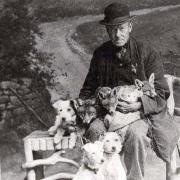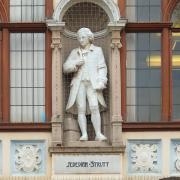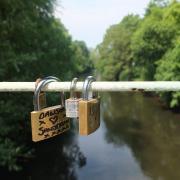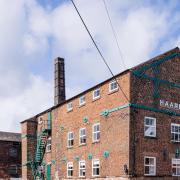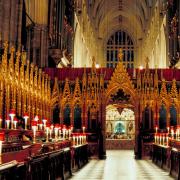Mike Smith visits the Dove Holes company that's putting art and craftmanship back in to our daily lives Leander Architectural
Ever since 1867, when the Royal Society of Arts fixed a blue plaque on the wall of Lord Byron's birthplace in Holles Street, it has been customary to remember individuals who have left their mark on the world by placing commemorative plaques on the buildings where they were born, lived or worked.English Heritage will only sanction a plaque carrying their logo if the individual concerned has been dead for at least twenty years, but other organisations take a rather different view. For example, Southwark Council recently placed a blue plaque on the birthplace of Manchester United and England footballer Rio Ferdinand, so making him a legend in his own lifetime. Erected in response to nominations from the public, all Southwark's commemorative wall-plates have been made by the Derbyshire firm of Leander, which is responsible for the production of similar plates on the walls of scores of significant buildings, not only in this country but also throughout the world. Leander's owners, Ted and Sue McAvoy, have their own nomination for the most deserving blue-plaque recipient: Henry Wood of Tottington, near Bury, who was born in 1603 and fought with Cromwell. After the Restoration, Henry was repeatedly persecuted for his Quaker beliefs and spent many years in Lancaster jail. When he was finally released at the age of 80, he still had sufficient energy and zeal to set sail for America, where he founded the community of Woodbury in New Jersey. In the millennium year, Woodbury and Bury were officially twinned and plaques made by Leander were unveiled in both towns to commemorate the occasion.Blue Plaques are but one aspect of the work of a firm which 'first started to cast interesting things in metal' in 1874. One of their earliest commissions came from Queen Victoria, who ordered a set of iron plant-labels for her rose garden at Sandringham. The raised lettering on the signs was a great boon to the queen, whose sight was fading, because it acted as a kind of Braille, and the commission was a great boon to the firm, which was rebranded as the Royal Label Factory.Until the 1960s, this was the company that was responsible for manufacturing most of the traffic signs on Britain's roads. These were cast in aluminium at a factory in Stratford-upon-Avon and then filled with hundreds of reflective glass beads, which were attached by two men who had the full-time task of gluing them on. As Ted says, 'This occupation would have made a perfect teaser for the What's My Line? panel.' When aluminium was superseded by vinyl, the firm turned its attention to the manufacture of street-name signs and to the production of heritage boards, particularly for the National Trust.The Royal Label Factory was managed for many years by members of the Froud family, who decided to relinquish their ownership in 1998. Anxious to ensure that their firm would pass into suitable hands, they offered the company, including their National Trust contract, to Leander, Tom and Sue McAvoy's Derbyshire firm, which had built up a reputation for the production of quality street furniture and the restoration of Victorian bandstands and conservatories.In the same year, the McAvoys opened a bronze foundry in North Wales, in order to carry out in-house architectural bronze casting, and also added an erection shop to their premises at Dove Holes, near Buxton, so that the firm could make and assemble complete bandstands before delivery. Not surprisingly, the transporter used to deliver these products often has only a few inches' clearance when passing under motorway bridges.Bandstands made by Leander are to be found in Buxton and Matlock, as well as in many other towns, ranging from Douglas in the Isle of Man to Folkestone in Kent. Some are contemporary in design, with strong echoes of 19th-century architecture. Others are faithful recreations of Victorian bandstands, but necessarily somewhat larger than the original structures, because modern brass bands differ from their predecessors in requiring accommodation for a percussion section.The BBC filmed Leander's reinstatement of an elevated bandstand near the sea-front in Brighton, where the firm is also renovating balustrades and building a bridge over the promenade. The dome of the Pavilion Gardens in Buxton was restored by the Derbyshire company in 1993, when dormer windows, eaves' railings and a new crown were added to the dome. At the same time, a large Victorian planter in the grounds was carefully reconstructed on the basis of just a few broken fragments found by the gardener.One of Leander's most striking restoration projects is to be found in Getliffe's Yard in Leek, where the restoration of a glazed arcade and the installation of elevated walkways and staircases have given a Georgian courtyard, comprising three cottages and a stables block, a new lease of life as a very attractive old-world location for businesses, craft shops and caf�s.Leander's restoration work is not confined to buildings: the firm's craftsmen are currently engaged in the painstaking restoration of a First World War locomotive that was used to ferry supplies to the trenches. This project is close to Ted's heart, because he is a great railway enthusiast, who named his firm after a famous class of steam locomotive and even has a narrow-gauge railway running around the perimeter of his factory.In recent years, Leander has been asked to produce memorial plaques for members of the Royal Marines killed in Iraq and Afghanistan. In each case, one plaque is produced for members of the marine's family and another for the memorial wall at Lympstone. This is one contract that Ted and Sue would be only too pleased to see reduced in size. Another area of work that occupies much of the company's time is the production of heritage boards, which are located as far afield as South Georgia, where they stand outside a whaling museum, and Antarctica, where one board carries a depiction of an early British base. Much closer to home, Leander's designers are currently producing relief maps and historical text from their own research for a series of interpretation panels in Tameside. They are also manufacturing eye-catching street furniture and theatre floor-plaques for the Yorkshire spa town of Harrogate.In recent years, many local authorities have become aware of the contribution made to regeneration by the installation of street sculptures and the erection of signposts, fingerposts, nameplates and boundary signs that have been fashioned in a style to match the age of surrounding buildings. Some other authorities have chosen to commission signs from Leander that are highly innovative. For example, compass direction signs to a series of old mills in Coventry have the appearance of spokes on a water-wheel and a notice asking people not to feed the ducks in a London park is inscribed on a piece of aluminium shaped like a loaf of bread. As Ted says, 'Every non-standard sign is a victory for vernacular architecture and individuality over standardisation; the greater the diversity, the more interesting a journey through Britain becomes.'Leander Architectural is based at Dove Holes, near Buxton. The company is a member of Peak District Products.Tel: 01298 814941 www.leanderarchitectural.co.uk









